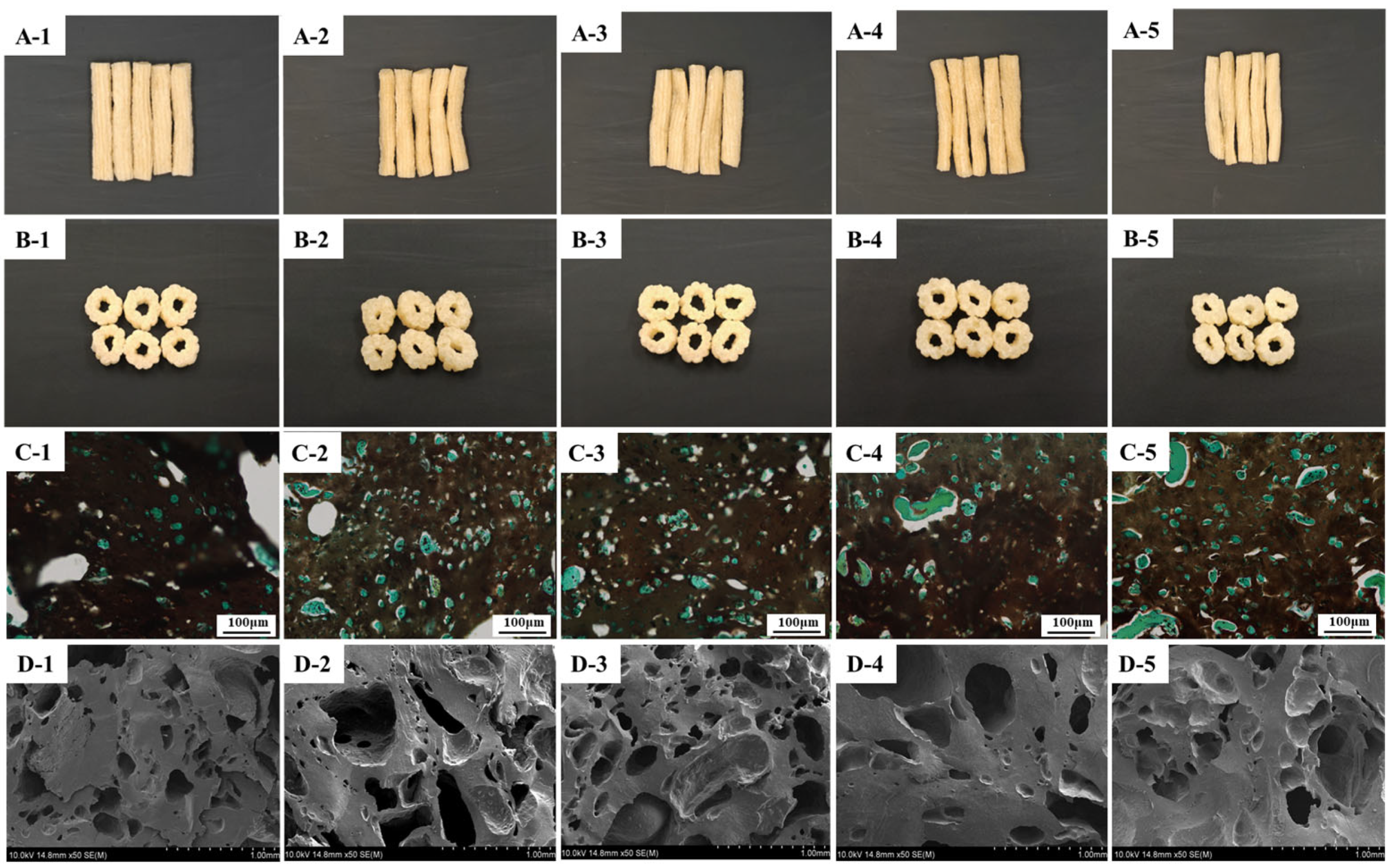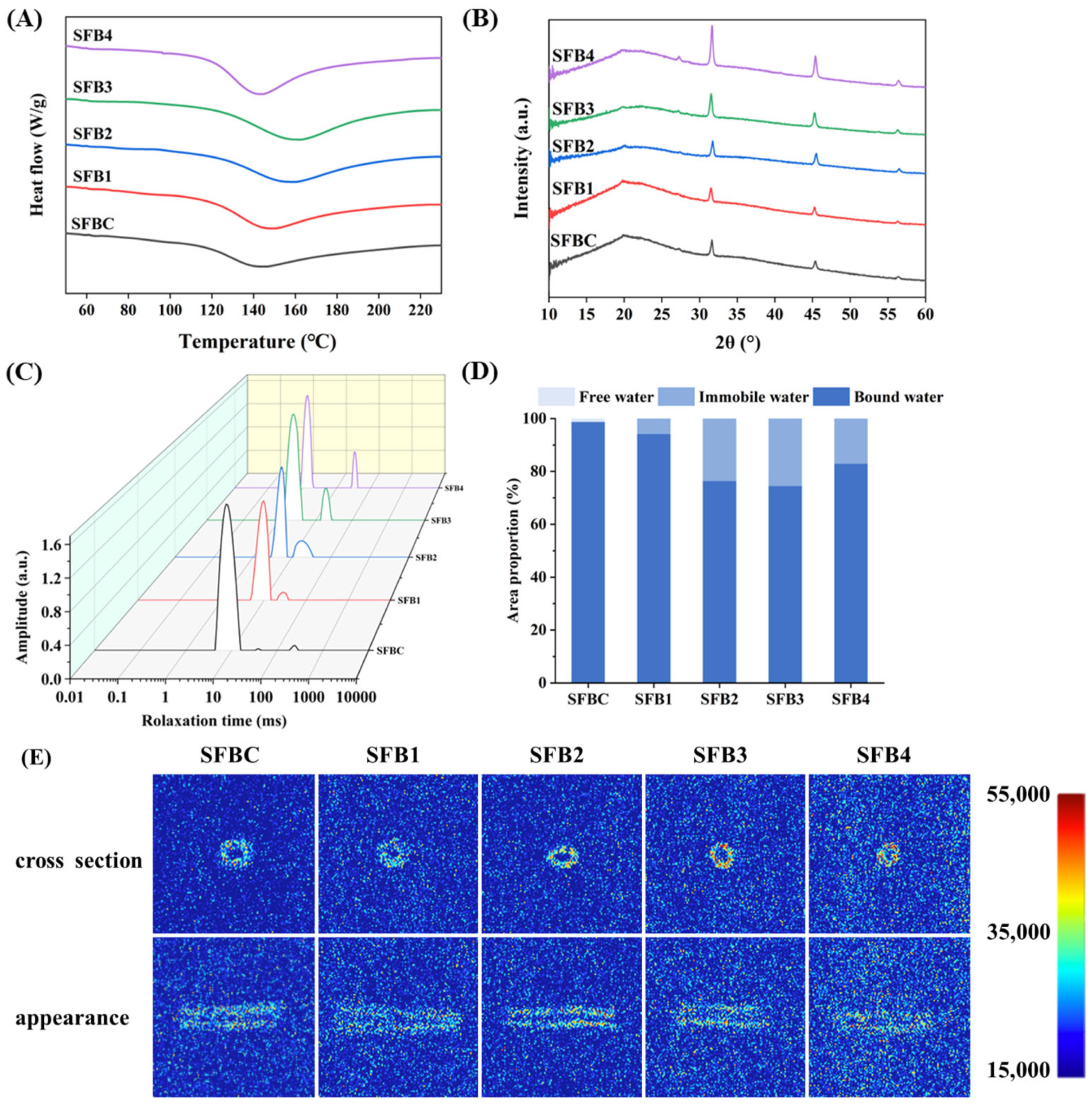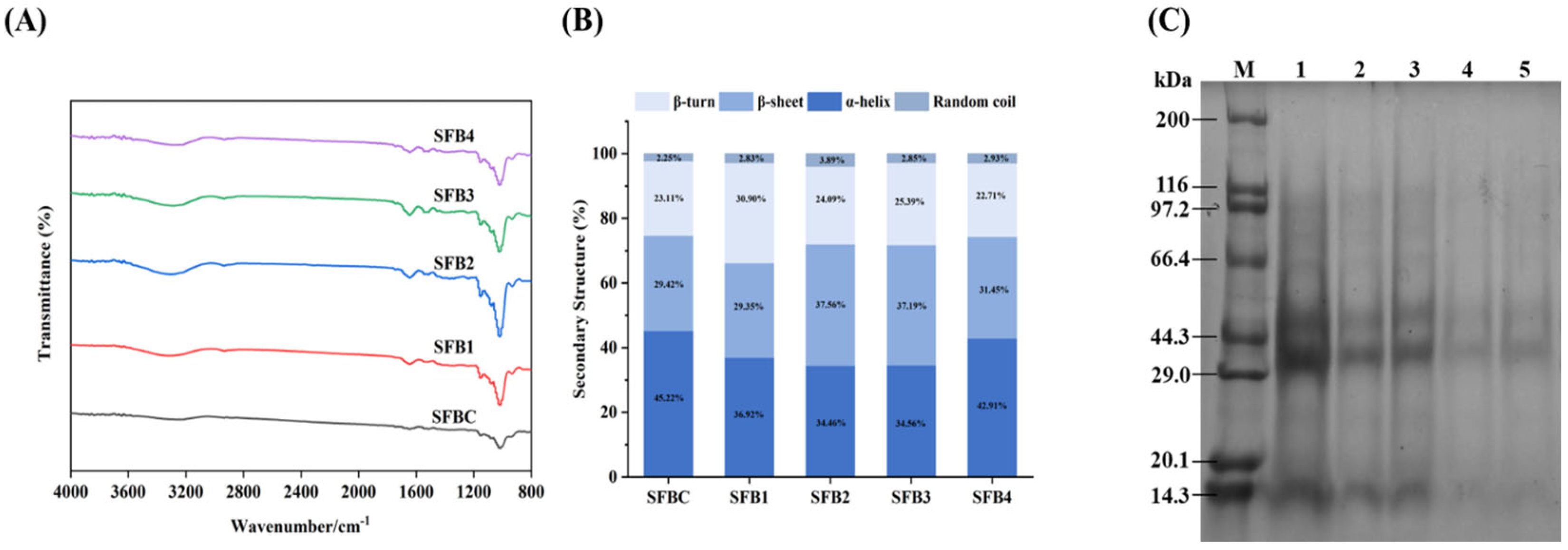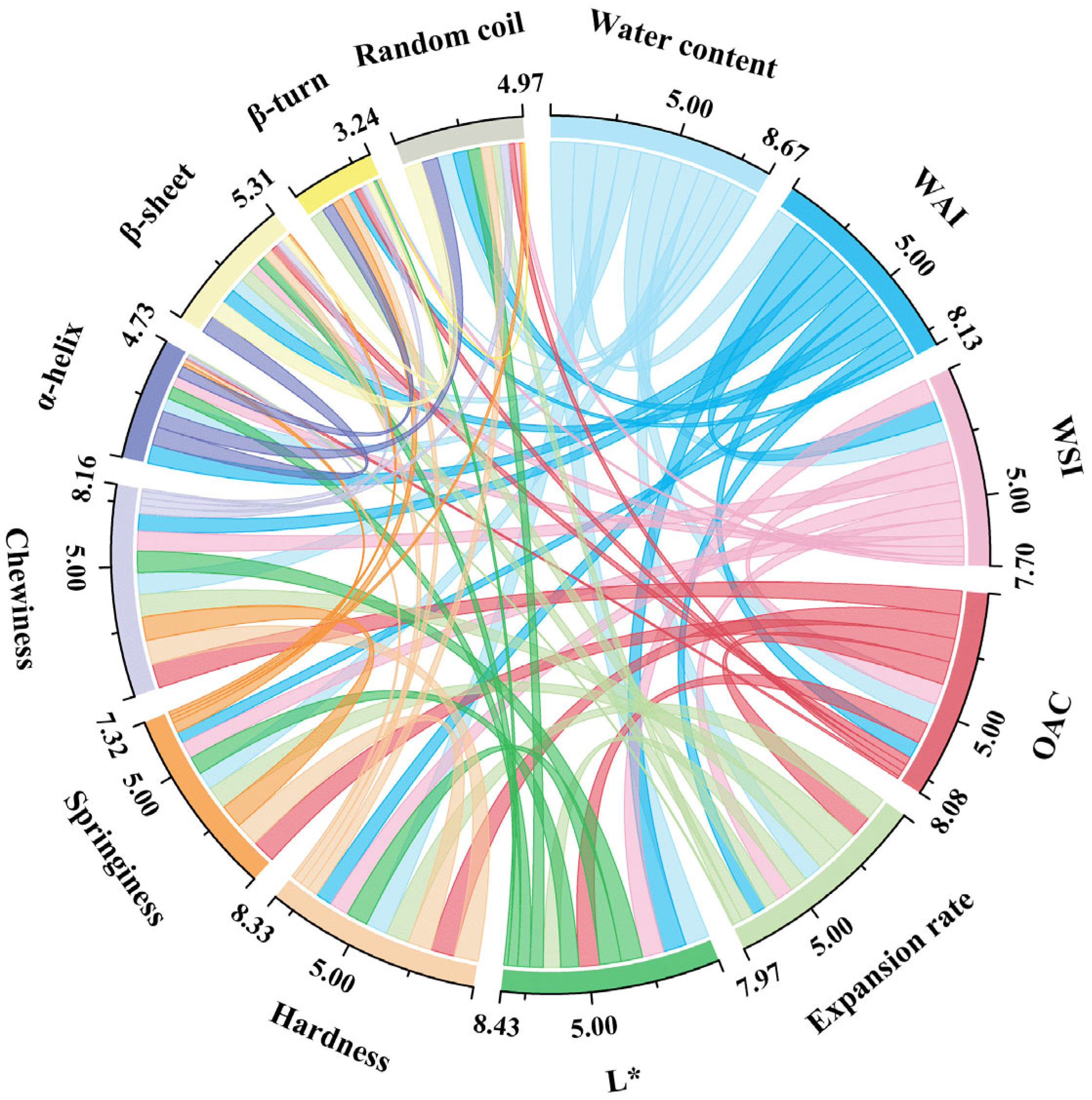Effects of the Ratio of Alaskan Pollock Surimi to Wheat Flour on the Quality Characteristics and Protein Interactions of Innovative Extruded Surimi–Flour Blends
Abstract
1. Introduction
2. Materials and Methods
2.1. Materials
2.2. Sample Preparation
2.3. Moisture Content, Water Absorption Index (WAI), and Water Solubility Index (WSI)
2.4. Oil Absorption Capacity (OAC)
2.5. Radial Expansion Rate (RER)
2.6. Sensory Analysis
2.7. Color Properties
2.8. Textural Properties
2.9. Microstructure Observation
2.9.1. Optical Microscopy (OM)
2.9.2. Scanning Electron Microscopy (SEM)
2.10. Differential Scanning Calorimetry (DSC)
2.11. X-Ray Diffraction (XRD)
2.12. Low-Field Nuclear Magnetic Resonance (LF-NMR) and Magnetic Resonance Imaging (MRI)
2.13. Secondary Structural Changes
2.14. SDS–PAGE
2.15. Statistical Analysis
3. Results and Discussion
3.1. Moisture Content, WAI, and WSI
3.2. OAC
3.3. RER
3.4. Sensory Evaluation
3.5. Color
3.6. TPA
3.7. Appearance and Microstructure
3.8. DSC
3.9. XRD
3.10. LF-NMR Relaxation and MRI Analyses
3.11. FTIR
3.12. SDS–PAGE
3.13. Correlation Analysis
4. Conclusions
Supplementary Materials
Author Contributions
Funding
Institutional Review Board Statement
Informed Consent Statement
Data Availability Statement
Conflicts of Interest
References
- Wang, D.D.; Han, W.F.; Shi, L.; Guo, X.J.; Chen, S.; Chen, L.; Qiao, Y.; Wu, W.J.; Li, J.T.; Wang, L. Effects of explosion puffing on surimi-starch blends: Structural characteristics, physicochemical properties, and digestibility. LWT 2023, 183, 114902. [Google Scholar] [CrossRef]
- Luo, S.W.; Koksel, F. Application of physical blowing agents in extrusion cooking of protein enriched snacks: Effects on product expansion, microstructure, and texture. Trends Food Sci. Technol. 2023, 133, 49–64. [Google Scholar] [CrossRef]
- Yang, H.; Fu, Y.; Zhang, Y.D.; Zhou, J.; Wang, D.F.; Gao, Z.; Ke, Y.; Lv, Q.Y.; Ding, B.B.; Wang, X.D. Evaluation of mannitol and xylitol on the quality of wheat flour and extruded flour products. Int. J. Food Sci. Technol. 2021, 56, 4119–4128. [Google Scholar] [CrossRef]
- Zhou, L.; Mu, T.H.; Ma, M.M.; Sun, H.N. Staling of potato and wheat steamed breads: Physicochemical characterisation and molecular mobility. Int. J. Food Sci. Technol. 2019, 54, 2880–2886. [Google Scholar] [CrossRef]
- Liu, Y.X.; Zhang, X.L.; Ding, B.B.; Ding, W.P.; Xiao, S.S.; Song, J.S.; Lyu, Q.Y.; Ke, Y.; Wang, X.D.; Fu, Y. Effect of hydrocolloids on physical, thermal and microstructure properties of par-baked baguette during frozen storage. Int. J. Biol. Macromol. 2020, 163, 1866–1874. [Google Scholar] [CrossRef]
- Swarnakar, A.K.; Mohapatra, M.; Das, S.K. A review on processes, mechanisms, and quality influencing parameters for puffing and popping of grains. J. Food Process. Preserv. 2022, 46, e16891. [Google Scholar] [CrossRef]
- Martin, A.; Osen, R.; Karbstein, H.P.; Emin, M.A. Linking expansion behaviour of extruded potato starch/rapeseed press cake blends to rheological and technofunctional properties. Polymers 2021, 13, 215. [Google Scholar] [CrossRef]
- Mao, Y.; Zhang, Y.H.; Li, T.T.; Chen, Y.Y.; Wang, Z.; Jin, W.P.; Shen, W.Y.; Li, J.L. Insight into the mechanism of gel properties, microstructure and flavor of surimi gels improved by wheat bran with different particle sizes. Food Res. Int. 2025, 201, 115601. [Google Scholar] [CrossRef]
- Fan, X.R.; Geng, W.H.; Li, M.; Wu, Z.X.; Li, Y.; Yu, S.; Zhao, G.H.; Zhao, Q.C. Performance and protein conformation of thermally treated silver carp (Hypophthalmichthys molitrix) and scallop (Argopecten irradians) blended gels. J. Sci. Food Agric. 2024, 104, 7797–7808. [Google Scholar] [CrossRef]
- Lu, Z.H.; Donner, E.; Yada, R.Y.; Liu, Q. Physicochemical properties and in vitro starch digestibility of potato starch/protein blends. Carbohydr. Polym. 2016, 154, 214–222. [Google Scholar] [CrossRef]
- Nawaz, A.; Li, E.; Khalifa, I.; Irshad, S.; Walayat, N.; Mohammed, H.H.H.; Zhang, Z.L.; Ahmed, S.; Simirgiotis, M.J. Evaluation of fish meat noodles: Physical property, dough rheology, chemistry and water distribution properties. Int. J. Food Sci. Technol. 2021, 56, 1061–1069. [Google Scholar] [CrossRef]
- Hou, Y.H.; Xia, S.G.; Ma, C.X.; Xue, C.H.; Jiang, X.M. Effects of the soy protein to wheat gluten ratio on the physicochemical and structural properties of Alaska pollock surimi-based meat analogs by high moisture extrusion. Food Res. Int. 2023, 173, 113469. [Google Scholar] [CrossRef]
- Liu, Y.X.; Leng, Y.; Xiao, S.S.; Zhang, Y.D.; Ding, W.P.; Ding, B.B.; Wu, Y.; Wang, X.D.; Fu, Y. Effect of inulin with different degrees of polymerization on dough rheology, gelatinization, texture and protein composition properties of extruded flour products. LWT Food Sci. Technol. 2022, 159, 113225. [Google Scholar] [CrossRef]
- Kaur, M.; Singh, B.; Kaur, A. Dry-air roasting impact on physicochemical, functional, antioxidant properties, phenolic profile and Maillard reaction products of flaxseed flour and cake flour. Food Chem. 2024, 442, 138571. [Google Scholar] [CrossRef]
- Bhinder, S.; Kaur, A.; Singh, B.; Yadav, M.P.; Singh, N. Proximate composition, amino acid profile, pasting and process characteristics of flour from different Tartary buckwheat varieties. Food Res. Int. 2020, 130, 108946. [Google Scholar] [CrossRef]
- Cao, Z.B.; Yu, C.; Yang, Z.; Xing, J.J.; Guo, X.N.; Zhu, K.X. Impact of gluten quality on textural stability of cooked noodles and the underlying mechanism. Food Hydrocoll. 2021, 119, 106842. [Google Scholar] [CrossRef]
- Lapčíková, B.; Burešová, I.; Lapčík, L.; Dabash, V.; Valenta, T. Impact of particle size on wheat dough and bread characteristics. Food Chem. 2019, 297, 124938. [Google Scholar] [CrossRef]
- Zhang, Y.F.; Chen, C.; Chen, Y.; Chen, Y. Effect of rice protein on the water mobility, water migration and microstructure of rice starch during retrogradation. Food Hydrocoll. 2019, 91, 136–142. [Google Scholar] [CrossRef]
- Fan, X.R.; Geng, W.H.; Zhang, X.Y.; Li, M.; Chang, K.X.; Ma, Y.S.; Benjakul, S.; Zhao, Q.C. Rice bran oil-in-water emulsion stabilized by Amur catfish myofibrillar protein: Characteristics and its application in surimi gels. Int. J. Biol. Macromol. 2024, 283, 137417. [Google Scholar] [CrossRef]
- Pei, Z.S.; Wang, H.B.; Xia, G.H.; Hu, Y.Q.; Xue, C.F.; Lu, S.S.; Li, C.; Shen, X.R. Emulsion gel stabilized by tilapia myofibrillar protein: Application in lipid-enhanced surimi preparation. Food Chem. 2023, 403, 134424. [Google Scholar] [CrossRef]
- Wang, J.R.; Guo, X.N.; Yang, Z.; Zhu, K.X. Effect of sodium bicarbonate on quality of machine-made Kongxin noodles. LWT 2021, 138, 110670. [Google Scholar] [CrossRef]
- Jeong, M.-S.; Cho, S.-J. Effect of pH-shifting on the water holding capacity and gelation properties of mung bean protein isolate. Food Res. Int. 2024, 177, 113912. [Google Scholar] [CrossRef] [PubMed]
- Li, X.D.; Zhang, T.H.; An, Y.Q.; Yin, T.; Xiong, S.B.; Rong, H.S. Physicochemical characteristics and flavor properties of texturized dual-proteins extrudates: Effect of surimi to soybean flour ratio. Foods 2022, 11, 3640. [Google Scholar] [CrossRef]
- Gao, Y.X.; Sun, Y.; Zhang, Y.; Sun, Y.K.; Jin, T. Extrusion modification: Effect of extrusion on the functional properties and structure of rice protein. Processes 2022, 10, 1871. [Google Scholar] [CrossRef]
- Ke, Y.; Ding, B.B.; Fu, Y.; Zhang, M.M.; Xiao, S.S.; Ding, W.P.; Yang, H.; Lv, Q.Y.; Zheng, Z.; Wang, X.D. Effects of chitosan oligosaccharide and hyriopsis cumingii polysaccharide on the quality of wheat flour and extruded flour products. Food Sci. Biotechnol. 2021, 30, 911–919. [Google Scholar] [CrossRef] [PubMed]
- Huang, G.F.; McClements, D.J.; Zhao, J.W.; Jin, Z.Y.; Chen, L. Effects of soy protein isolates and transglutaminase addition on the structure, physicochemical properties, and oil absorption of wheat flour. Food Chem. 2025, 479, 143824. [Google Scholar] [CrossRef]
- Chen, Y.H.; McClements, D.J.; He, K.; Zhang, Z.P.; Zhang, R.J.; Zhao, J.W.; Jin, Z.Y.; Chen, L. Effect of transglutaminase on the structure, properties and oil absorption of wheat flour. Food Chem. 2025, 463, 141117. [Google Scholar] [CrossRef]
- Bisharat, G.I.; Katsavou, I.D.; Panagiotou, N.M.; Krokida, M.K.; Maroulis, Z.B. Investigation of functional properties and color changes of corn extrudates enriched with broccoli or olive paste. Food Sci. Technol. Int. 2015, 21, 613–630. [Google Scholar] [CrossRef]
- Zang, P.; Gao, Y.; Chen, P.; Lv, C.Y.; Zhao, G.H. Recent advances in the study of wheat protein and other food components affecting the gluten network and the properties of noodles. Foods 2022, 11, 3824. [Google Scholar] [CrossRef]
- Jiang, X.; Chen, Q.; Xiao, N.Y.; Du, Y.F.; Feng, Q.; Shi, W.Z. Changes in gel structure and chemical interactions of hypophthalmichthys molitrix surimi gels: Effect of setting process and different starch addition. Foods 2022, 11, 9. [Google Scholar] [CrossRef]
- Mi, H.B.; Li, Y.; Wang, C.; Yi, S.M.; Li, X.P.; Li, J.R. The interaction of starch-gums and their effect on gel properties and protein conformation of silver carp surimi. Food Hydrocoll. 2021, 112, 106290. [Google Scholar] [CrossRef]
- Zhang, Y.J.; Zhang, J.C.; Chen, Q.L.; He, N.; Wang, Q. High-moisture extrusion of mixed proteins from soy and surimi: Effect of protein gelling properties on the product quality. Foods 2022, 11, 1397. [Google Scholar] [CrossRef]
- Kumar, R.; Xavier, K.A.M.; Lekshmi, M.; Balange, A.; Gudipati, V. Fortification of extruded snacks with chitosan: Effects on techno functional and sensory quality. Carbohydr. Polym. 2018, 194, 267–273. [Google Scholar] [CrossRef]
- Liu, Y.N.; Yu, S.L.; Jiang, P.F.; Fu, B.S.; Qi, L.B.; Shang, S. Effect of exogenous protein substitution in glutinous rice cake: Batter rheology, structure, and retrogradation behavior. J. Cereal Sci. 2024, 119, 104006. [Google Scholar] [CrossRef]
- Zambrano, Y.; Contardo, I.; Moreno, M.C.; Bouchon, P. Effect of extrusion temperature and feed moisture content on the microstructural properties of rice-flour pellets and their impact on the expanded product. Foods 2022, 11, 198. [Google Scholar] [CrossRef]
- Yang, D.; Wu, G.C.; Li, P.Y.; Qi, X.G.; Zhang, H.; Wang, X.G.; Jin, Q.Z. The effect of fatty acid composition on the oil absorption behavior and surface morphology of fried potato sticks via LF-NMR, MRI, and SEM. Food Chem. X 2020, 7, 100095. [Google Scholar] [CrossRef] [PubMed]
- Li, S.; Liu, Y.; Huang, J.B.; Sun, N.; Jiao, J.; Dong, X.P.; Jiang, P.F. Feasibility of puffing and volatile compounds characteristics of fish maw, a protein-based raw material. LWT 2024, 212, 116963. [Google Scholar] [CrossRef]
- Chang, Q.; Zheng, B.D.; Zhang, Y.; Zeng, H.L. A comprehensive review of the factors influencing the formation of retrograded starch. Int. J. Biol. Macromol. 2021, 186, 163–173. [Google Scholar] [CrossRef] [PubMed]
- Shao, Y.L.; Jiao, R.Z.; Wu, Y.Y.; Xu, F.C.; Li, Y.; Jiang, Q.J.; Zhang, L.; Mao, L.C. Physicochemical and functional properties of the protein–starch interaction in Chinese yam. Food Sci. Nutr. 2023, 11, 1499–1506. [Google Scholar] [CrossRef] [PubMed]
- Jiang, X.; Liu, J.Y.; Xiao, N.Y.; Zhang, X.H.; Liang, Q.Q.; Shi, W.Z. Characterization of the textural properties of thermally induced starch-surimi gels: Morphological and structural observation. Food Biosci. 2024, 58, 103675. [Google Scholar] [CrossRef]
- Luo, X.Y.; Xiao, S.T.; Ruan, Q.F.; Gao, Q.; An, Y.Q.; Hu, Y.; Xiong, S.B. Differences in flavor characteristics of frozen surimi products reheated by microwave, water boiling, steaming, and frying. Food Chem. 2022, 372, 131260. [Google Scholar] [CrossRef]
- Chen, L.; Tian, Y.Q.; Zhang, Z.P.; Tong, Q.Y.; Sun, B.H.; Rashed, M.M.A.; Jin, Z.Y. Effect of pullulan on the digestible, crystalline and morphological characteristics of rice starch. Food Hydrocoll. 2017, 63, 383–390. [Google Scholar] [CrossRef]
- Guo, J.J.; Yang, L.; Wang, D.L.; Lian, X.J.; Liu, C. Research on the influences of two alcohol soluble glutenins on the retrogradation of wheat amylopectin/amylose. Int. J. Biol. Macromol. 2021, 183, 463–472. [Google Scholar] [CrossRef]
- Niu, H.L.; Zhang, M.C.; Xia, X.F.; Liu, Q.; Kong, B.H. Effect of porcine plasma protein hydrolysates on long-term retrogradation of corn starch. Food Chem. 2018, 239, 172–179. [Google Scholar] [CrossRef]
- Zhu, S.C.; Wang, Y.Y.; Ding, Y.C.; Xiang, X.W.; Yang, Q.; Wei, Z.P.; Song, H.; Liu, S.L.; Zhou, X.X. Improved texture properties and toughening mechanisms of surimi gels by double network strategies. Food Hydrocoll. 2024, 152, 109900. [Google Scholar] [CrossRef]
- Yu, X.S.; Wang, P.; Wang, L.S.; Wang, K.X.; Duan, Y.M.; Huo, J.J.; Ma, X.Q.; Dong, S.Z.; Xin, G.; Xiao, Z.G. Inhibition mechanism of rice glutelin on extruded starch digestion: From the structural properties of starch and enzyme activity. Food Res. Int. 2024, 175, 113790. [Google Scholar] [CrossRef]
- Cao, G.; Chen, X.T.; Wang, N.; Tian, J.; Song, S.J.; Wu, X.Y.; Wang, L.; Wen, C.R. Effect of konjac glucomannan with different viscosities on the quality of surimi-wheat dough and noodles. Int. J. Biol. Macromol. 2022, 221, 1228–1237. [Google Scholar] [CrossRef]
- Ezeanaka, M.C.; Nsor-Atindana, J.; Zhang, M. Online low-field nuclear magnetic resonance (LF-NMR) and magnetic resonance imaging (MRI) for food quality optimization in food processing. Food Bioprocess Technol. 2019, 12, 1435–1451. [Google Scholar] [CrossRef]
- Liu, C.K.; Li, W.X.; Lin, B.Y.; Yi, S.M.; Ye, B.B.; Mi, H.B.; Li, J.R.; Wang, J.X.; Li, X.P. Comprehensive analysis of ozone water rinsing on the water-holding capacity of grass carp surimi gel. LWT Food Sci. Technol. 2021, 150, 111919. [Google Scholar] [CrossRef]
- Luo, H.B.; Guo, C.X.; Lin, L.; Si, Y.L.; Gao, X.; Xu, D.L.; Jia, R.; Yang, W.G. Combined use of rheology, LF-NMR, and MRI for characterizing the gel properties of hairtail surimi with potato starch. Food Bioprocess Technol. 2020, 13, 637–647. [Google Scholar] [CrossRef]
- Shivaraju, V.K.; Appukuttan, V.S.; Kumar, S. The influence of bound water on the FTIR characteristics of starch and starch nanocrystals obtained from selected natural sources. Starch 2019, 71, 1700026. [Google Scholar]
- Tian, J.M.; Qin, L.K.; Zeng, X.F.; Ge, P.Z.; Fan, J.; Zhu, Y. The role of amylose in gel forming of rice flour. Foods 2023, 12, 1210. [Google Scholar] [CrossRef] [PubMed]
- Min, C.; Geng, J.Z.; Liu, C.X.; Wang, Y.H.; Huang, J.R.; Xiong, Y.L.L. Structural changes of flaxseed protein modified by fermentation and the gel properties and swallowing characteristics of its composite system with mung bean starch. LWT 2024, 199, 116098. [Google Scholar] [CrossRef]
- Hu, Y.M.; Wang, L.J.; Li, Z.G. Modification of protein structure and dough rheological properties of wheat flour through superheated steam treatment. J. Cereal Sci. 2017, 76, 222–228. [Google Scholar] [CrossRef]
- Xiao, Z.G.; Jiang, R.S.; Huo, J.J.; Wang, H.G.; Li, H.; Su, S.; Gao, Y.Z.; Duan, Y.M. Rice bran meat analogs: Relationship between extrusion parameters, apparent properties and secondary structures. LWT Food Sci. Technol. 2022, 163, 113535. [Google Scholar] [CrossRef]





| Sample | L* | a* | b* | hab* | Cab* | ΔE |
|---|---|---|---|---|---|---|
| SFBC | 92.15 ± 0.54 a | 5.96 ± 0.05 c | −0.43 ± 0.03 a | −0.07 ± 0.00 a | 5.98 ± 0.04 d | 7.31 ± 0.01 e |
| SFB1 | 90.10 ± 0.43 b | 6.00 ± 0.08 c | −0.60 ± 0.06 a | −0.10 ± 0.01 a | 6.03 ± 0.08 d | 7.82 ± 0.22 d |
| SFB2 | 90.07 ± 0.14 b | 6.06 ± 0.09 bc | −1.78 ± 0.11 b | −0.29 ± 0.02 b | 6.32 ± 0.08 c | 8.13 ± 0.04 c |
| SFB3 | 89.83 ± 0.19 bc | 6.14 ± 0.04 ab | −2.49 ± 0.15 c | −0.39 ± 0.02 c | 6.63 ± 0.04 b | 8.51 ± 0.09 b |
| SFB4 | 89.24 ± 0.13 c | 6.21 ± 0.06 a | −4.65 ± 0.26 d | −0.64 ± 0.03 d | 7.77 ± 0.11 a | 9.75 ± 0.18 a |
| Sample | Texture | DSC | ||||
|---|---|---|---|---|---|---|
| Hardness (N) | Springiness | Chewiness (mJ) | T0 (°C) | Tp (°C) | ∆H (J/g) | |
| SFBC | 38.34 ± 2.49 a | 1.36 ± 0.05 a | 32.68 ± 2.40 a | 123.68 ± 5.20 a | 148.74 ± 11.09 ab | 59.87 ± 8.60 b |
| SFB1 | 36.14 ± 1.80 ab | 1.32 ± 0.09 ab | 26.63 ± 2.57 b | 122.6 ± 3.27 a | 141.74 ± 4.63 b | 61.02 ± 4.04 b |
| SFB2 | 33.82 ± 3.02 b | 1.24 ± 0.10 bc | 23.44 ± 1.17 c | 126.05 ± 1.99 a | 159.20 ± 5.45 a | 116.83 ± 4.56 a |
| SFB3 | 33.46 ± 1.78 b | 1.16 ± 0.04 c | 20.46 ± 1.15 d | 125.83 ± 2.85 a | 157.02 ± 6.90 ab | 124.83 ± 5.26 a |
| SFB4 | 29.50 ± 2.66 c | 0.86 ± 0.06 d | 11.55 ± 0.83 e | 120.74 ± 3.72 a | 142.22 ± 9.51 b | 117.83 ± 11.93 a |
Disclaimer/Publisher’s Note: The statements, opinions and data contained in all publications are solely those of the individual author(s) and contributor(s) and not of MDPI and/or the editor(s). MDPI and/or the editor(s) disclaim responsibility for any injury to people or property resulting from any ideas, methods, instructions or products referred to in the content. |
© 2025 by the authors. Licensee MDPI, Basel, Switzerland. This article is an open access article distributed under the terms and conditions of the Creative Commons Attribution (CC BY) license (https://creativecommons.org/licenses/by/4.0/).
Share and Cite
Fan, X.; Zhang, X.; Zhou, Y.; Song, M.; Li, M.; Benjakul, S.; Li, Z.; Zhao, Q. Effects of the Ratio of Alaskan Pollock Surimi to Wheat Flour on the Quality Characteristics and Protein Interactions of Innovative Extruded Surimi–Flour Blends. Foods 2025, 14, 2851. https://doi.org/10.3390/foods14162851
Fan X, Zhang X, Zhou Y, Song M, Li M, Benjakul S, Li Z, Zhao Q. Effects of the Ratio of Alaskan Pollock Surimi to Wheat Flour on the Quality Characteristics and Protein Interactions of Innovative Extruded Surimi–Flour Blends. Foods. 2025; 14(16):2851. https://doi.org/10.3390/foods14162851
Chicago/Turabian StyleFan, Xinru, Xinyue Zhang, Yingying Zhou, Maodong Song, Meng Li, Soottawat Benjakul, Zhibo Li, and Qiancheng Zhao. 2025. "Effects of the Ratio of Alaskan Pollock Surimi to Wheat Flour on the Quality Characteristics and Protein Interactions of Innovative Extruded Surimi–Flour Blends" Foods 14, no. 16: 2851. https://doi.org/10.3390/foods14162851
APA StyleFan, X., Zhang, X., Zhou, Y., Song, M., Li, M., Benjakul, S., Li, Z., & Zhao, Q. (2025). Effects of the Ratio of Alaskan Pollock Surimi to Wheat Flour on the Quality Characteristics and Protein Interactions of Innovative Extruded Surimi–Flour Blends. Foods, 14(16), 2851. https://doi.org/10.3390/foods14162851







